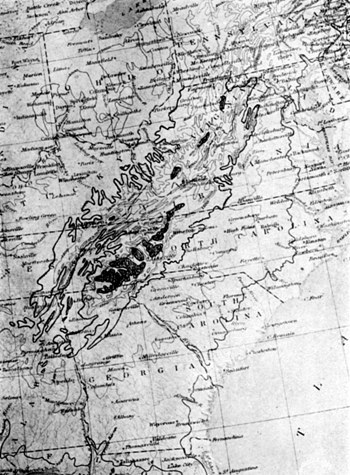
Some people think that Kentuckians, with their ways and customs, still lived in the 18th century. The reason is Appalachia, a far-reaching mountain range that is difficult to reach.
In 1728, when Colonel William Byrd of Westover ran the boundary line between Virginia and North Carolina, he was repulsed by parallel chains of savage, unpeopled mountains that rose tier beyond tier to the westward, everywhere densely forested and matted into jungle by laurel and other undergrowth. In his Journal, writing in the quaint, old-fashioned way, he said: “Our country has now been inhabited more than 130 years by the English, and still we hardly know anything of the Appalachian Mountains, that is nowhere above 250 miles from the sea. Whereas the French, who are later comers, have ranged from Quebec Southward as far as the Mouth of Mississippi, in the bay of Mexico, and to the West almost as far as California, which is either way above 2,000 miles.”
A hundred and thirty years later, the same thing could have been said of these same mountains for the “fierce and uncouth races of men” that startled the nation on the scene of our Civil War by sending 180,000 of their riflemen into the Union Army.
Miss Ellen Semple described the isolation of the mountaineers in a fine monograph published in the Geographical Journal of London in 1901 as follows:
“These Kentucky mountaineers are cut off from the outside world and separated from each other. Each is confined to his locality and finds his little world within a radius of a few miles from his cabin. Many men in these mountains have never seen a town or even the poor village that constitutes their county seat… The women … are almost as rooted as the trees. We met one woman who, during the twelve years of her married life, had lived only ten miles across the mountain from her own home but had never returned home to visit her father and mother. Another in Perry County told me she had never been farther from home than Hazard, the county seat only six miles distant. Another had never been to the post office, four miles away, and another had never seen the ford of the Rockcastle River, only two miles from her home, and marked, moreover, by the country store of the district.”
When I first went into the Smokies, I stopped one night in a single-room log cabin and soon had the good people absorbed in my tales of travel beyond the seas. Finally, the housewife said with pathetic resignation, “Bushnell’s the first ever I’ve been.” At that time, Bushnell was a hamlet of thirty people, only seven miles from where we sat. When I lived alone on “the Little Fork of Sugar Fork of Hazel Creek,” there were women in the neighborhood, young and old, who had never seen a railroad and men who had never boarded a train, although the Murphy branch ran within sixteen miles of our post-office. The first time that a party of these people went to the railroad, they were uneasy and suspicious. Nearing the way-station, a girl in advance came upon the first negro she ever saw in her life, and ran screaming back: “My goddamighty, Mam, thar’s the boogerman—I done seed him!”
Jane Barlow says of certain remote parts of Erin: “In Bogland if you inquire the address of such or such person, you will hear not very infrequently that he or she lives ‘off away at the Back of Beyond.’… A Traveler to the Back of Beyond may consider himself rather exceptionally fortunate should he find that he can arrive at his destination by any conveyance other than ‘the two standin’ feet of him.’ Often enough, the last stage of his journey proceeds down some boggy boreen, or up some craggy hill-track, inaccessible to any wheel or hoof that ever was shod.”
So, in Appalachia, one step short of the railway, was described as primitive, and most of the river valleys as narrow. “The soil is rich in its bottoms, the farms are well-kept and generous, and the owners are comfortable and sophisticated. But from the valleys directly spring the mountains, with slopes rising twenty to forty degrees or more. These mountains cover nine-tenths of western North Carolina, and among them dwell most of the native people.”
“The backcountry is rough. No boat nor canoe can stem its brawling waters. No bicycle or automobile can enter it. No coach can endure its roads. Here is a land of lumber wagons, saddlebags, and shackly little sleds dragged over the bare ground by harnessed steers. This is the country that ordinary tourists shun. And well for such that they do, since whoso cares more for bodily comfort than for freedom and air and elbow-room should tarry by still waters and pleasant pastures. To him, the backwoods could be only what Burns called Argyleshire: “A country where savage streams tumble over savage mountains, thinly overspread with savage flocks, which starvingly support as savage inhabitants.”
Source: Our Southern Highlanders by Horace Kephart.